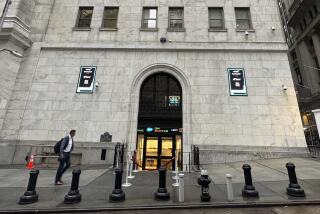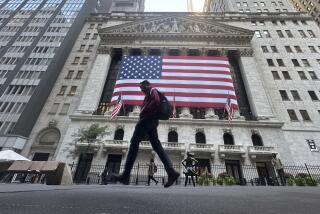Wall Street rolls to the edge of records as hopes remain for rate cuts

NEW YORK â U.S. stocks rose Friday after some mixed signals on big banksâ profits and inflation did little to dent Wall Streetâs belief that easier interest rates are on the way.
The Standard & Poorâs 500 climbed 0.6% to close its fifth winning week in the last six. The Dow Jones industrial average rose 0.6%, and the Nasdaq composite added 0.6%. All three indexes had been on track to set all-time highs in afternoon trading but finished shy of them.
Bank of New York Mellon climbed 5.2% for one of the marketâs bigger gains after it reported better profit for the spring than analysts expected. Nvidia and other highly influential Big Tech stocks also helped lift the market after a slide Thursday, which interrupted their rocket ride higher amid a frenzy around artificial-intelligence technology.
They helped offset a drop for Wells Fargo, which sank 6% even though the San Francisco bank reported stronger profit than analysts expected. It said a key underlying measure of profit fell from a year earlier and that its net interest income could remain in the bottom half of the range it had forecast for the full year.
In the bond market, which has been home to some of Wall Streetâs strongest action this week, Treasury yields yo-yoed after the release of the latest update on inflation. It said prices rose more at the wholesale level last month than economists expected, which was a letdown after data on Thursday said inflation at the consumer level was better than expected.
But after a couple of initial swings, Treasury yields calmed and remained lower than they were late Thursday.
âItâs still going to take some time before we know whether yesterdayâs number or todayâs was the aberration,â said Chris Larkin, managing director of trading and investing at E-Trade from Morgan Stanley.
Some of the acceleration in Fridayâs data could be the result of higher profit margins for businesses, which can swing sharply and some analysts called irrelevant to the inflation fighters at the Federal Reserve.
Also helping to keep yields anchored was a report suggesting U.S. households arenât as fearful about inflation staying so high in the future. Over the coming year, U.S. consumers are forecasting inflation of 2.9%, according to preliminary data from the University of Michigan.
Itâs the second straight month such expectations have eased. That helps calm worries about a potential spiral in which expectations for high inflation could drive U.S. consumers toward behavior that would push inflation even higher. That in turn could give the Federal Reserve more of the evidence of slowing inflation that it says it needs to begin cutting its main interest rate, which is at its highest level in more than two decades.
After climbing as high as 4.23% after the wholesale inflation reportâs release, the 10-year Treasury yield settled back down to 4.18% from 4.21% late Thursday. Itâs down from 4.70% in April as hopes have risen that inflation is slowing enough to convince the Fed to cut short-term rates.
Traders are banking on a 94% probability that the Federal Reserve will start easing rates in September, according to data from CME Group. Lower interest rates would release pressure thatâs built up on the economy because of how expensive itâs become to borrow money to buy houses, cars or anything on credit cards. Fed officials, though, have been saying they want to see âmore good dataâ on inflation before making a move.
Lower interest rates would help all types of businesses, and smaller companies could see particularly big benefits because of their borrowings to grow. The smaller stocks in the Russell 2000 rose more than the S&P 500 index on Thursday, breaking a long-standing trend, and that continued Friday.
The Russell 2000 rallied 1.1%, nearly double the S&P 500âs gain, and closed out its best week in eight months.
All told, the S&P 500 rose 30.81 points to 5,615.35. The Dow gained 247.15 points to 40,000.90, and the Nasdaq composite added 115.04 points to close at 18,398.45.
Of course, traders have a long history of being premature about forecasting rate cuts. JPMorgan Chase Chief Executive Jamie Dimon warned Friday that inflation and interest rates may stay higher than the market expects because of the U.S. governmentâs growing debt and other factors.
In stock markets abroad, Japanâs Nikkei 225 gave back some of its recent record-breaking run and fell 2.4%, though itâs still up more than 23% for the year so far.
Indexes were mixed across the rest of Asia and higher in much of Europe.
Choe writes for the Associated Press.
More to Read
Inside the business of entertainment
The Wide Shot brings you news, analysis and insights on everything from streaming wars to production â and what it all means for the future.
You may occasionally receive promotional content from the Los Angeles Times.










